Plants to soften edges of paths
Plants to soften edges of paths. I do like a neat path, whether it’s made of hard bricks or concrete, soft grass, or anything in between. And most of all, I like them when their crisp lines have been softened by flowering plants spilling over the edges from growing beds next to the paths. It looks more natural, more appealing, and more of an invitation to walk along the path and see what is at the end.
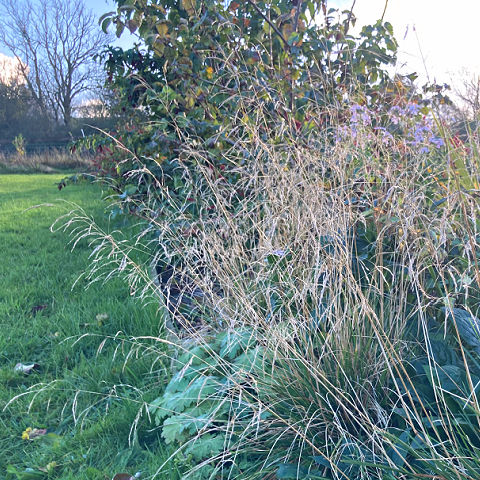
While you could grow almost any plant next to a pathway, some are more robust and will tolerate being brushed past on a regular basis and cope with occasionally being stood on. You could select one species to grow on both sides of a path, which will give uniformity and the effect of formality, like a low hedge. Or you can choose an abundance of size, form, and colour for a more relaxed and natural look. And don’t feel that you must stick to very low-growing plants, because walking among tall plants gives the feeling of being immersed in the garden.
Here’s a look at some great low-growing, but not all ground-hugging, mostly herbaceous perennial plants for softening the hard lines of paths in your garden. To support the wildlife population, leave the stems in place over winter and then cut back in late spring as the new growth appears. If you leave cut stems on the ground for a few days, it will give sleeping insects a chance to move before you all the stems to the compost heap.
Alchemilla mollis

I think that once you have Alchemilla mollis in your garden, you are likely to have it forever because it freely self-seeds. The leaves hold rain and dew on the very edges, making them look jewel encrusted. Commonly known as lady’s mantle, it is a very hardy plant that is unfussy about type of soil, situation, or position, although it does prefer moist, but well-drained soil. 50cms height and width. The stems of frothy, lime green to yellow flowers are ideal for cutting. If the plant starts to look scruffy in late summer, you can cut the foliage back hard and new growth will appear. Propagate by seed or by division in spring or autumn.
Campanula portenschlagiana

This Campanula quickly forms a dense mat of small evergreen foliage around 15cm height and in excess of 50cm. It grows well in walls, rockeries and gaps between paving stones as well as in borders. It will fail to thrive in heavy and clay soils or in full shade, but otherwise is unfussy about situation, position or aspect. During the summer it produces a mass of purple bell-shaped flowers. Take basal cuttings for reliable propagation. It also grows readily from seed and may seed freely around the garden.
Deschampsia cespitosa ‘Goldschleier’

Grasses can be good plants option to soften hard edges of paths in the garden. Not only does their form and shape provide interest, but the movement of the leaves and flower stems in the wind helps to blur the lines between hard landscaping and borders. I’ve been growing Deschampsia cespitosa ‘Goldschleier’ for a couple of years and have been impressed with its performance. It’s perennial evergreen that forms a clump with arching blue-green leaves. From late spring or early summer, it produces flower stems with golden colour flowers that have a silvery sheen. The stems and seed heads stand for months. I tend to leave the flowering stems, but you can cut them down in late spring. Height 90cm and 60cm spread.
Silene fimbriata

An interesting, herbaceous perennial that produces white flowers during summer. The distinctive flowers have a puffy base which persists long after the frilly petals have finished. It prefers lighter soils that are moist, but well-draining, so will fail to thrive in clay soil. Grow in full sun or partial shade. It is hardy in most of the UK, even during a severe winter. Height and spread 60cm. Propagate by seed or division of clumps. If you have heavy, clay soil, try growing Silene fimbriata in a pot or raised bed that has plenty of grit added to the compost to increase the drainage.
Geranium Mrs Kendall Clarke
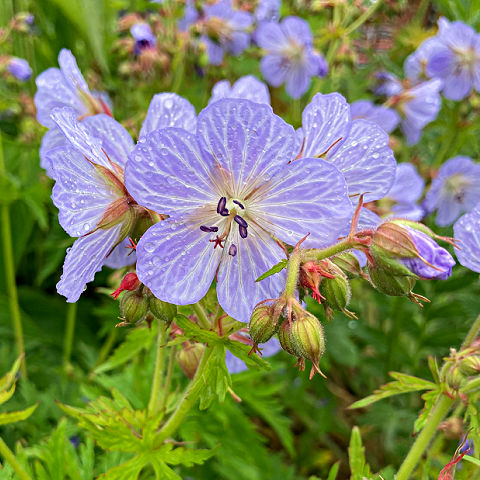
There are masses of Geranium varieties to choose from, and I particularly like the soft colour and veining in the petals of ‘Mrs Kendall Clarke’ and the deeply cut, lobed leaves. It is happy in full sun and partial shade in most situations, although may struggle on a north-facing site. That said, it grows happily in our open and sunny north facing garden. They prefer a moist, but not waterlogged soil. It flowers throughout summer, deadhead regularly to encourage more flower production. Height and spread 60cm. Propagate by division in spring.
Scabiosa ‘Kudo White’

I am excited to grow this for the first time this year, I’ve chosen it to soften the edges of new paths in our back garden. The creamy white scabious flowers will attract pollinators to the garden. This herbaceous perennial forms a clump of 50cm height and width and it prefers full sun. Grow near the front of the border or in pots and deadhead regularly for a flower display through to late September.
Pulmonaria Blue Ensign
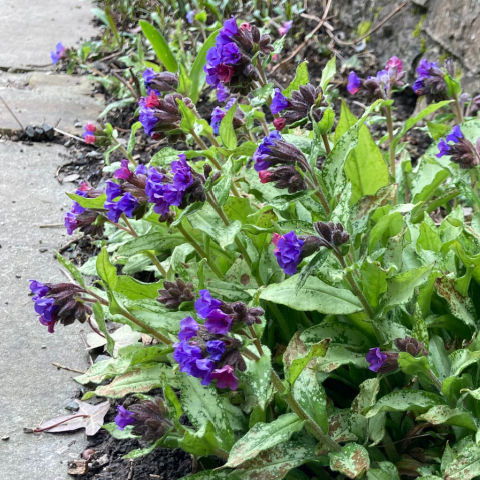
Here’s a good plant for a shadier spot. Pulmonaria prefers partial shade or full shade and may struggle in a south-facing spot. Grows well in all but sandy soils and prefers a moist, but well-drained soil. It is semi-evergreen, meaning that in a mild winter, it may keep its leaves. Commonly called lungwort, it is hardy throughout the UK, even during a severe winter. In spring, it produces a host of violet-blue flowers that are mostly held above the dark green leaves that attract pollinating insects to the garden. 30cm height and 50cm spread. This plant has won the RHS Award of Garden Merit.
Hosta ‘Francee’ (fortunei)
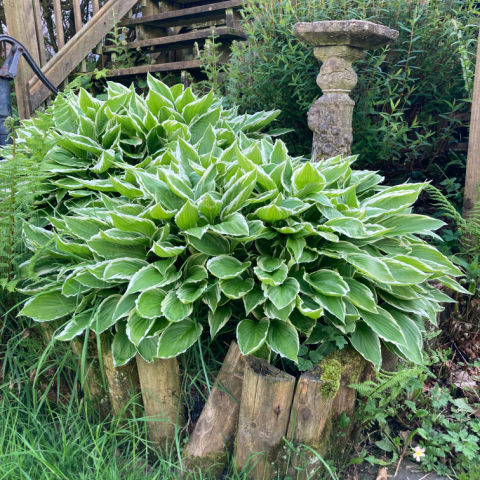
There are so many varieties of Hosta to choose from and all are plants that will soften the edges the paths well. Hosta ‘Francee’ (fortunei) has slightly puckered, heart-shaped leaves with white margins. In July and August, flower spikes appear with pale lavender-blue flowers. It prefers fertile, moist, but well-drained soil. Grow in partial shade or shade. Fully hardy throughout the UK and Ireland. Height 55cm and spread 100cm. Propagate by division. To promote large and lush leaves, feed in spring with a generous mulch of garden compost around the plant. Spraying the leaves with a high-nitrogen feed, such as stinging nettle tea, during the growing season will also encourage larger leaves.
Erigeron karvinskianus

The popularity of Erigeron karvinskianus has boomed over the last few years, and rightly so! The Mexican fleabane produces a mass of typical daisy flowers with a yellow centre. The petals open as white, but become pink-purple as they age. The plants form a mat up to 30cm height and over 50cm spread. It is unfussy about soil type as long as it is well-drained. It is drought-tolerant, although produces a larger plant with more flowers if it does not dry out for long periods. Grow in full sun in all but a north-facing garden. Hardy throughout most of UK and Ireland.
Oxalis vulcanicola ‘Plum Crazy’ (v)
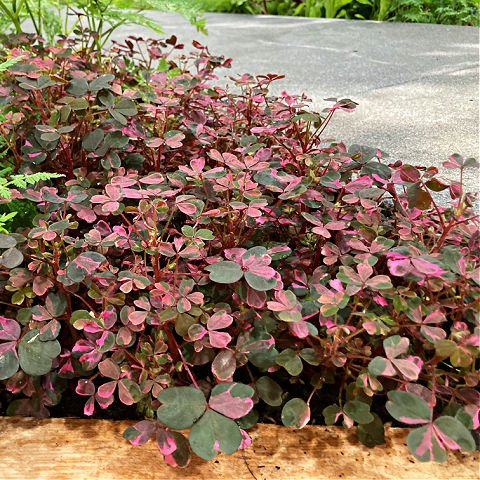
I first saw this in a display at Chelsea Flower Show last year and was immediately attracted by the colouring of the leaves. The leaf shape reminds me of a three-leaf clover and with the addition of pink splashes of colour across the leaves, it’s an attractive plant. It bears pink and white, star-shaped flowers in summer and autumn. It is more demanding than many plants on this list, but I think it’s worth it. Oxalis vulcanicola ‘Plum Crazy’ (v) is a tender plant that will cope with being in the garden during summer, but will not survive freezing temperatures. Lift and move to a frost-free environment before the first frost. It requires loamy or sandy soil and will fail to thrive in chalk or clay. It needs partial shade in a sheltered, west- or east-facing spot. Height 20cm and 30cm spread.
Oca
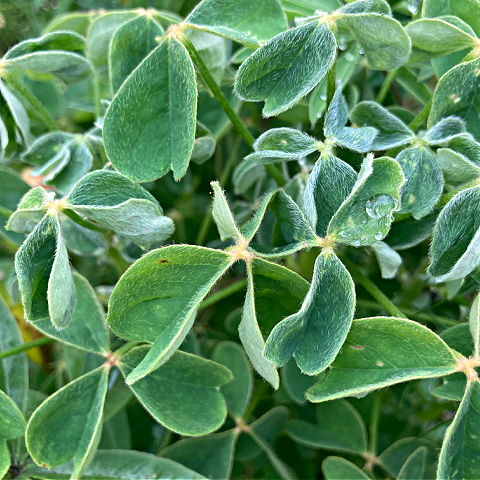
Many herbs will fulfil the role of tumbling over the edges of paths, but why not try something a little more unusual. Oca is a tuberous vegetable from the Andes. The small knobbly tubers are harvested after the first frosts. They are available in a variety of colour tubers from white through pinks to dark red. They can be eaten raw, grated into salads when they have the crunchy texture of a radish or cooked, they are especially good when roasted. It has slightly fleshy, trifoliate leaves and fairly insignificant yellow flowers. I’ve been growing it as ground cover for the last 8 years, harvesting just a few tubers each year.
More information
The article about plants to soften the edges of paths was written for Amateur Gardening magazine in late spring 2025. However, I may have updated some of the specific varieties and images. Additionally, links are included to help you find the suggested plants. You can also look at some great ground cover plants.
- Baby pepper inside pepper | Strange vegetable - September 16, 2025
- Biennials to sow in June and July - September 12, 2025
- Protected: Urban back garden - August 28, 2025
